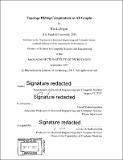Topology hiding computation on all graphs
Author(s)
LaVigne, Rio (Kristen Rio)
DownloadFull printable version (2.782Mb)
Other Contributors
Massachusetts Institute of Technology. Department of Electrical Engineering and Computer Science.
Advisor
Vinod Vaikuntanathan.
Terms of use
Metadata
Show full item recordAbstract
A distributed computation in which nodes are connected by a partial communication graph is called topology-hiding if it does not reveal information about the graph beyond what is revealed by the output of the function. Previous results have shown that topology-hiding computation protocols exist for graphs of constant degree and logarithmic diameter in the number of nodes [Moran-Orlov-Richelson, TCC'15; Hirt et al., Crypto'16] as well as for other graph families, such as cycles, trees, and low circumference graphs [Akavia-Moran, Eurocrypt'17], but the feasibility question for general graphs was open. In this work we positively resolve the above open problem: we prove that topology-hiding computation is feasible for all graphs under the Decisional Diffie-Hellman assumption. Our techniques employ random or deterministic walks to generate paths covering the graph, upon which we apply the Akavia-Moran topology-hiding broadcast for chain-graphs (paths). To prevent topology information revealed by the random-walk, we design multiple graph-covering sequences that, together, are locally identical to receiving at each round a message from each neighbor and sending back a processed message from some neighbor (in a randomly permuted order).
Description
Thesis: S.M., Massachusetts Institute of Technology, Department of Department of Electrical Engineering and Computer Science, 2017. Cataloged from PDF version of thesis. Includes bibliographical references (pages 63-65).
Date issued
2017Department
Massachusetts Institute of Technology. Department of Electrical Engineering and Computer SciencePublisher
Massachusetts Institute of Technology
Keywords
Electrical Engineering and Computer Science.